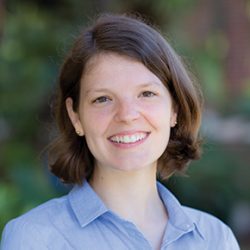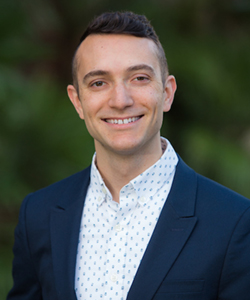Amanda Krause, Ph.D., and Ryan Need, Ph.D., assistant professors in the Department of Materials Science & Engineering at the University of Florida, have each received National Science Foundation (NSF) Faculty Early Career Development (CAREER) Awards. As one of NSF’s most prestigious honors, CAREER Awards recognize junior faculty who possess the potential to serve as academic role models in research and education and to lead advances in the mission of their department or organization. Dr. Krause’s research will help uncover the underlying mechanism for grain growth in ceramic materials to guide new processing methods for achieving their optimal performance. Dr. Need’s research will create new measurement capabilities and knowledge in the field of nanoscale ion diffusion.
Controlling Grain Growth in Ceramics

A wide variety of high-tech applications, from airplane engines to microprocessors, utilize ceramic components. Many of these ceramics are composed of features found at the mesoscopic level known as grains, whose size dictates many of the material’s properties – including its resistance to cracking. One of the most significant challenges when fabricating reliable ceramic parts is the ability to control the size of the grains because they grow unpredictably at the high temperatures required for processing ceramics.
“There are many factors that contribute to grain growth in ceramics, but it is unclear which of them can be effectively used to engineer unique material properties,” Dr. Krause said. “If we can gain understanding regarding the underlying mechanisms of grain growth, we’ll be able to control better the microstructure’s behavior during the manufacturing process. With that ability, we can improve the performance of these materials.“
Grain size optimization experiments currently involve a significant amount of trial-and-error testing, which is inefficient and slows progress. Instead, Dr. Krause will use a novel experimental approach to drive grain growth by utilizing a magnetic field. With this method, she can detangle the multiple components that influence microstructure behavior.
“Using a magnetic field allows us to manipulate the material locally to observe grain growth. By understanding the material’s response, we can engineer new processing pathways for better ceramics,” Dr. Krause said.
Dr. Krause and her team are conducting their grain growth studies using a new 3D microscopy tool that uses X-rays to characterize the internal structure of the ceramics non-destructively. This tool allows her to collect 4D data (3D plus time) to measure individual grain boundary velocities and correlate them to local features, something conventional microscopy techniques cannot deliver.
Dr. Krause’s program will also help train the next generation of ceramic engineers with the necessary skills for similar research, with a ceramic-processing kit currently under development for implementation in K-12 schools.
“By bringing the ceramic art and scientific communities together, students will get to learn how the creative process also applies to engineering and manufacturing,” Dr. Krause said.
Nanoscale Ion Diffusion

Traditionally, computers have relied on electronic technologies (moving electrons back and forth between different materials) for information storage and data processing tasks. However, new technologies are now emerging that move oxygen ions in and out of ceramic thin films to alter their chemistry, and in turn, change their properties, like electrical resistance or magnetism, to enable faster and more efficient computing.
By engineering the vacancies in the atomic structure of transition metal oxides, e.g., iron oxide or cobalt oxide, as a pathway for oxygen ions to move between materials, Dr. Need and their team hope to span the gaps between the existing ionic and electronic technologies to create something brand new.
“It’s sometimes referred to as ‘ionotronics’ or ‘ion-tronics,’ and has immense potential for the next generation of information storage and processing technology,” Dr. Need said.
The expected advantages of this approach include greater energy efficiency, longer information storage lifetimes and the ability to support new computing paradigms like quantum computing.
“Unfortunately,” Dr. Need said, “the inherent challenge of making accurate measurements of oxygen diffusion in these nanoscale thin films creates a bottleneck in our ability to understand how different materials and interfaces might help or hamper oxygen ion movement at such small scales.”
Dr. Need’s research addresses that measurement challenge by developing a new technique based on X-ray and neutron scattering to accurately calculate oxygen migration through stacks of different thin films.
“From that data, we can extract information about the oxygen migration barriers created by each layer and also the interfaces between them,” they said. “We can then use this insight to design technologies based on ion motion with the same precision that enables silicon-based electronics today.”
In addition to the research, the CAREER award also supports an educational outreach component to provide low-cost activity kits and free training videos to help K-12 teachers introduce students to materials science concepts. Free, online videos will complement these kits to reinforce the concepts learned and connect them back to the ongoing research.
“Experiences like this help create a pipeline of enthusiastic young scientists with an early knowledge of materials science principles and ideas about how they can use them to create greener technologies for the future,” Dr. Need said.
